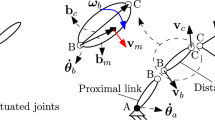Abstract
A variable stiffness actuator (VSA) is considered a promising mechanism-based approach for realizing compliant robotic manipulators. By changing the stiffness of each joint, the robot can modulate the stiffness of the entire system to enhance safety and efficiency during physical interaction with other systems. This paper presents a feedforward method to modulate the operational stiffness of a parallel planar robot with multiple VSAs. A VSA utilizing a lever mechanism was developed, clearly presenting its mechanical design and kinematic model details. A computational model of joint-restoring torque was developed based on deformation measurements and hysteresis loop geometry to estimate the applied torque of each joint in real-time. An algorithm was proposed to compute the joint stiffness solution using the robot's kinematic model for modulating the operational stiffness of the parallel robot. Experiments were performed to evaluate the proposed method by comparing the performances of two DOF serial and parallel robot systems. The results demonstrated the capability of the VSA in both feedforward stiffness modulation and external force estimation.





















Similar content being viewed by others
References
Schiavi R, Bicchi A, Flacco F (2009) Integration of active and passive compliance control for safe human-robot coexistence. IEEE Int Conf Robot Autom 2009:259–264. https://doi.org/10.1109/ROBOT.2009.5152571
Bicchi A, Tonietti G (2004) Fast and “soft-arm” tactics [robot arm design]. IEEE Robot Autom Mag 11(2):22–33. https://doi.org/10.1109/MRA.2004.1310939
Grioli G, Wolf S, Garabini M et al (2015) Variable Stiffness Actuators: The User’s point of view. Int J Robot Res 34(6):727–743
Ren Z, Roozing W (2018) The eLeg: A novel efficient leg prototype powered by adjustable parallel compliant actuation principles. Humanoids, pp455–461
Jafari A, Tsagarakis N, Vanderborght B, Caldwell D (2010) A novel actuator with adjustable stiffness (AwAS). Proc. of IEEE/RSJ Int. Conf. on Intelligent Robots and Systems, pp 4201–4206
Lee JH, Wahrmund C, Jafari A (2017) A novel mechanically overdamped actuator with adjustable stiffness (MOD-AwAS) for safe interaction and accurate positioning. Actuators 6(3):1–6
Kircanski NM, Goldenberg AA (1997) An experimental study of nonlinear stiffness, hysteresis, and friction effects in robot joints with harmonic drives and torque sensors. Int J Robot Res 16(2):214–239
Tjahjowidodo T, Al-Bender F, Van Brussel H (2013) Theoretical modelling and experimental identification of nonlinear torsional behaviour in harmonic drives. Mechatronics 23(5):497–504. https://doi.org/10.1016/j.mechatronics.2013.04.002
Ruderman M, Bertram T, Iwasaki M (2014) Modeling, observation, and control of hysteresis torsion in elastic robot joints. Mechatronics 24(5):407–415. https://doi.org/10.1016/j.mechatronics.2014.02.009
Kim D-H, Oh J-H (2019) Hysteresis modeling for torque control of an elastomer series elastic actuator. IEEE/ASME Trans Mechatronics 24(3):1316–1324
Serio A, Grioli G, Sardellitti I, Tsagarakis NG, Bicchi A (2011) A decoupled impedance observer for a variable stiffness robot. IEEE Int Conf Robot Autom 2011:5548–5553. https://doi.org/10.1109/ICRA.2011.5980158
Lin X, Peng C, Yin Y (2019) A real-time variable stiffness measuring method consisted of residual-based estimator and parametric observer. Proceedia CIRP 83:773–778. https://doi.org/10.1016/j.procir.2019.04.106
Ning Y, Liu Y, Xi F, Huang K, Li B (2021) Human-robot interaction control for robot driven by variable stiffness actuator with force self-sensing. IEEE Access 9:6696–6705. https://doi.org/10.1109/ACCESS.2020.3048418
Colomé A, Pardo D, Alenyà G, Torras C (2013) External force estimation during compliant robot manipulation. IEEE Int Conf Robot Autom 2013:3535–3540. https://doi.org/10.1109/ICRA.2013.6631072
Kallu KD, Jie W, Lee MC (2018) Sensorless reaction force estimation of the end effector of a dual-arm robot manipulator using sliding mode control with a sliding perturbation observer. Int J Control Autom Syst 16:1367–1378. https://doi.org/10.1007/s12555-017-0154-7
Lee JH, Yi BJ, Lee JY (2012) Adjustable spring mechanisms inspired by human muscloskeletal structure. Mechanism and Machine Theory
Ohe T, Lee JH, Okamoto S (2019) Experimental verification of nonlinear characteristics with hysteresis in variable stiffness robotic joint. 2019 16th International Conference on Ubiquitous Robots (UR), pp 128–132 https://doi.org/10.1109/URAI.2019.8768632
Ohe T, Lee JH, Okamoto S (2021) Mechanical design and torque estimation model of a variable stiffness joint with hysteresis characteristics. 2021 7th International Conference on Mechatronics and Robotics Engineering (ICMRE), pp 137–141 https://doi.org/10.1109/ICMRE51691.2021.9384847
Jafari A, Tsagarakis N, Caldwell D (2015) Energy efficient actuators with adjustable stiffness: a review on AwAS, AwAS-II and CompACT VSA changing stiffness based on lever mechanism. Ind Robot 42(3):242–251. https://doi.org/10.1108/IR-12-2014-0433
Torsion Springs, Lee Spring Company, Available online: https://www.leespring.com/torsion-springs (Accessed on 1 Nov 2021)
Baber TT, Noori MN (1986) Modeling general hysteresis behavior and random vibration application. Trans ASME 108:411–420
Merry RJE, van de Molengraft MJG (2010) Velocity and acceleration estimation for optical incremental encoders. Mechatronics 20(1):20–26
Hace A (2019) The improved division-less MT-type velocity estimation algorithm for low-cost FPGAs. Electronics 8(3):1–24
Gerolymos N, Gazetas G (2005) Phenomenological model applied to inelastic response of soil-pile interaction systems. Soils Found 45(4):119–132
Janaideh MA, Rakheja S, Su C-Y (2009) A generalized Prandtl-Ishlinkii model for characterizing the hysteresis and saturation nonlinearities of smart actuators. Smart Mater Struct 18:1–9
Qin H, Bu N, Chen W, Yin Z (2014) An asymmetric hysteresis model and parameter identification method for piezoelectric actuator. Math Probl Eng 2014:932974
Acknowledgement
This work was supported by JSPS KAKENHI Grant Number JP19K04312.
Author information
Authors and Affiliations
Corresponding author
Additional information
Publisher's Note
Springer Nature remains neutral with regard to jurisdictional claims in published maps and institutional affiliations.
Rights and permissions
About this article
Cite this article
Ohe, T., Alemayoh, T.T., Lee, J.H. et al. Feedforward operational stiffness modulation and external force estimation of planar robots equipped with variable stiffness actuators. Intel Serv Robotics 15, 179–192 (2022). https://doi.org/10.1007/s11370-022-00412-y
Received:
Accepted:
Published:
Issue Date:
DOI: https://doi.org/10.1007/s11370-022-00412-y



